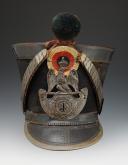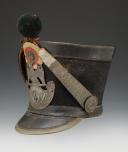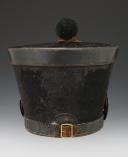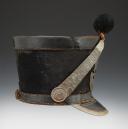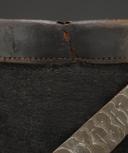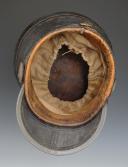
SHAKO OF THE 4th REGIMENT OF CHASSEURS À CHEVAL, model 1812, First Empire. 30239.
Sold out
SHAKO OF THE 4th REGIMENT OF CHASSEURS À CHEVAL, model 1812, First Empire. 30239
Body composed of a 18 cm tall felt, covered by a waxed cow leather cap, very strong, with a diameter of 24 cm folded over the felt over a height of 3.5 cm. At the bottom of the felt, a 2.5 cm wide plain cow leather chinstrap with a iron buckle and pin at the back, buckle height 2.7 cm, width 2.3 cm. Below the chinstrap, a simple calf gusset, to facilitate the movement of the chinstrap. Visor made of strong varnished cow leather, sewn at the front of the shako, adorned with an iron band folded over its outer edge, visor width 6 cm. White iron plate, height 13.4 cm, width 11.2 cm, 1812 type, with a crowned eagle with the lower escutcheon stamped with a hunting horn in the center of which the number "4" is cut out. Three-color painted boiled leather cockade attached to the felt by steel threads, diameter 7 cm; white circle on the outside, then red and blue in the center. Below the cockade, a gusset sewn for the pompom. Each chinstrap composed of a double sheepskin strap on which are mounted 15 iron scales alternately cut in two or three festoons, plus a sixteenth circular at the end, the first scale is 3.3 cm wide, the second slightly less and decreasing to the last which is 2 cm wide. Each of these scales are each stopped by a flat iron wire and terminated with a lace. Chinstraps attached by a rosette, called "big button" in the 1812 regulation, made of the same metal as the chinstrap, 4.2 cm in diameter; it is bordered by a raised molding, in the center a hunting horn is embossed in relief.
Interior cap composed of a leather headband topped with a large ecru canvas.
Round green woolen pompom, diameter 5.9 cm.
France.
First Empire.
Good condition, some holes and moth grazes on the felt, part of the cap folded on the right side split along its height with repair at the seam. Slightly oxidized front plate, posterior chinstrap laces.
NOTE:
This shako can be attributed to the 4th Chasseurs à Cheval Regiment due to its metallic circled visor, a characteristic found in cavalry headgear.
HISTORICAL BACKGROUND:
As the regiment is covered in glory, its headquarters is established on January 22, 1800, in Bourg and its cantonment in Pont d'Ain. The command of the headquarters is entrusted to Chief of Squadron Bellon, who also, following requests from the prefect of Ain, serves as inspector for the Italic Legion and military police officer. The stay of the 4th chasseurs in Bourg is marked by the presence of the Italic Legion and many Italian civilian refugees, leading to a wheat crisis in the department. On the 25th of Floréal an VIII, in order to feed the 60 horses of the 4th chasseurs headquarters, a requisition of forage is ordered in the communes of Bourg, Pont de Vaux, St Trivier de Courtes, Bâgé, Pont de Veyle, Coligny, Treffort, Chavannes, Ceyzériat, and Montrevel. While announcing his decree, Chief of Squadron Bellon informs that he is still expecting 400 remount horses.
Alarmed by the large number of horses to come, the prefect of Ain asks the commissioner of wars Quinet and the storekeeper of military forage if they can supply the forage. They respond that it is impossible for them. Knowing that the Ain department is exhausted and ruined, especially due to the passage of the men from the Italic Legion and Italian refugees, the decision is made to relocate the 4th chasseurs headquarters. The prefect of Ain writes to General Montigny, military commander of the 6th military division in Besançon, the ordnance commissioner of the same military division, and General Romand, military commander of Ain on the same day to give orders to the chief squadron of the 4th chasseurs to proceed to another destination as indicated and to formally oppose any troop movements in this department.
On the 3rd of Prairial an VIII, General Romand, commander of Ain and Jura, assures the prefect of Ain that he has strongly insisted on the removal of the regiment's headquarters from Bourg. The requests of the prefect of Ain succeed, as the departure of the headquarters is set for July 17, 1800. To organize the regiment's departure correctly, Bellon, the chief squadron of the 4th chasseurs, in charge of the headquarters, requests the prefect of Ain on July 13 to bring back the detachments of the regiment present in Pont d'Ain and Meximieux to Bourg to change the horses and harnesses. For its 6-month presence in Ain, the 4th chasseurs regiment is owed 13,053 francs by the state, which is equivalent to 5 decades of salary.
The regiment takes part in the Italian campaign in 1800, and during this campaign on the 13th Frimaire An IX (4th December 1800), Verdet achieves eternal glory. Likely a non-commissioned officer, he goes on patrol with 4 chasseurs towards the village of Stellata. There, the chasseurs come under fire from an Austrian sentinel. Verdet charges her, knocking her down with a saber stroke and then heads towards another post with rifles, which he captures. In the heat of the action, Verdet rushes the guard post and takes 9 other prisoners.
Officers killed and wounded (1805-1815)
Killed: 21; Died from their wounds: 1; Wounded: 48
(Sources: Tony Broughton)
In 1804, the regiment receives 4 eagles and Challiot model guidons. That same year 1804, a squadron is detached to Martinique until 1812. In 1805, it is with the army in Naples (under the command of Masséna, Verdier division - Ed.) and fights at Padua on November 5, Venice, and St Michel. From 1806 to 1812, it is involved in the pacification of Calabria and Puglia. The fights are replaced by skirmishes, and their colonel, Bruguière, is even assassinated by bandits on October 28, 1806, near Gaeta.
In 1812, when the Martinique squadron rejoins the regiment, it receives 4 eagles with damaged service guidons (3 are returned). The flag is of the 1812 model without inscription, and it is used during the campaign in Russia. The regiment is with the Grande Armée, Beurmann brigade of the III corps, and takes part in the Russian campaign. It then has 34 officers and 669 men. It fights at Valutina (August 19, 1812), at Borodino (September 7, 1812), in Vitebsk (November 7, 1812), and Krasnoe (November 14-18, 1812), in the Berezina (November 26, 1812).
During the retreat on November 18, 1812, the eagle is captured by the Russian Poltava regiment. The remnants of the 4th fight at the Berezina (November 26-28, 1812), and in the campaign of 1813 at Katzbach (August 26, 1813), Wachau, and Leipzig (October 16 and 18).
In 1814, it fights at Montmirail (February 11) and Arcis-sur-Aube (March 20-21). During the First Restoration, the regiment is renamed the Chasseurs de Monsieur regiment and merges with the remnants of the 19th chasseurs. In 1815, during the Hundred Days, it receives 1 eagle and a 1815 model flag. It is in the Army of the North and fights at Ligny (June 16) and Waterloo (June 18 - Vandamme's III Corps, Domont's 3rd Cavalry Division).
Upon the second abdication, it does not surrender its eagle at Bourges and is disbanded in December 1815. Its men are then transferred to the 21st chasseurs.
Battles and conflicts
1793: Wissembourg, Fort Vauban, Brumpt, Vantzenau, Kaiserlautern, Gambsheim, Haguenau
1794: Schwegenheim, Trippstadt, Kaiserlautern, Mannheim
1796: Neustadt, Kehl, Renchen, Rastadt, Elttingen, Neubourg, Biberach
1797: Passage of the Piave and Tagliamento, Chissanto, Weng
1799: Bergen, Alkmaar, Kastricum, Haarlem
1800: Crossing of the Mincio, siege of Mantua
1801: Rivalto, Verona, Saint-Pierre
1805: Padua, siege of Venice, Saint-Michel
1812: Crossing of the Neman, Vitebsk, Krasnoe, Smolensk, Valutina, Borodino, Berezina
1813: Katzbach, Wachau, Leipzig, Glogau
1814: Montmirail, Arcis-sur-Aube
1815: Ligny, Waterloo
Body composed of a 18 cm tall felt, covered by a waxed cow leather cap, very strong, with a diameter of 24 cm folded over the felt over a height of 3.5 cm. At the bottom of the felt, a 2.5 cm wide plain cow leather chinstrap with a iron buckle and pin at the back, buckle height 2.7 cm, width 2.3 cm. Below the chinstrap, a simple calf gusset, to facilitate the movement of the chinstrap. Visor made of strong varnished cow leather, sewn at the front of the shako, adorned with an iron band folded over its outer edge, visor width 6 cm. White iron plate, height 13.4 cm, width 11.2 cm, 1812 type, with a crowned eagle with the lower escutcheon stamped with a hunting horn in the center of which the number "4" is cut out. Three-color painted boiled leather cockade attached to the felt by steel threads, diameter 7 cm; white circle on the outside, then red and blue in the center. Below the cockade, a gusset sewn for the pompom. Each chinstrap composed of a double sheepskin strap on which are mounted 15 iron scales alternately cut in two or three festoons, plus a sixteenth circular at the end, the first scale is 3.3 cm wide, the second slightly less and decreasing to the last which is 2 cm wide. Each of these scales are each stopped by a flat iron wire and terminated with a lace. Chinstraps attached by a rosette, called "big button" in the 1812 regulation, made of the same metal as the chinstrap, 4.2 cm in diameter; it is bordered by a raised molding, in the center a hunting horn is embossed in relief.
Interior cap composed of a leather headband topped with a large ecru canvas.
Round green woolen pompom, diameter 5.9 cm.
France.
First Empire.
Good condition, some holes and moth grazes on the felt, part of the cap folded on the right side split along its height with repair at the seam. Slightly oxidized front plate, posterior chinstrap laces.
NOTE:
This shako can be attributed to the 4th Chasseurs à Cheval Regiment due to its metallic circled visor, a characteristic found in cavalry headgear.
HISTORICAL BACKGROUND:
As the regiment is covered in glory, its headquarters is established on January 22, 1800, in Bourg and its cantonment in Pont d'Ain. The command of the headquarters is entrusted to Chief of Squadron Bellon, who also, following requests from the prefect of Ain, serves as inspector for the Italic Legion and military police officer. The stay of the 4th chasseurs in Bourg is marked by the presence of the Italic Legion and many Italian civilian refugees, leading to a wheat crisis in the department. On the 25th of Floréal an VIII, in order to feed the 60 horses of the 4th chasseurs headquarters, a requisition of forage is ordered in the communes of Bourg, Pont de Vaux, St Trivier de Courtes, Bâgé, Pont de Veyle, Coligny, Treffort, Chavannes, Ceyzériat, and Montrevel. While announcing his decree, Chief of Squadron Bellon informs that he is still expecting 400 remount horses.
Alarmed by the large number of horses to come, the prefect of Ain asks the commissioner of wars Quinet and the storekeeper of military forage if they can supply the forage. They respond that it is impossible for them. Knowing that the Ain department is exhausted and ruined, especially due to the passage of the men from the Italic Legion and Italian refugees, the decision is made to relocate the 4th chasseurs headquarters. The prefect of Ain writes to General Montigny, military commander of the 6th military division in Besançon, the ordnance commissioner of the same military division, and General Romand, military commander of Ain on the same day to give orders to the chief squadron of the 4th chasseurs to proceed to another destination as indicated and to formally oppose any troop movements in this department.
On the 3rd of Prairial an VIII, General Romand, commander of Ain and Jura, assures the prefect of Ain that he has strongly insisted on the removal of the regiment's headquarters from Bourg. The requests of the prefect of Ain succeed, as the departure of the headquarters is set for July 17, 1800. To organize the regiment's departure correctly, Bellon, the chief squadron of the 4th chasseurs, in charge of the headquarters, requests the prefect of Ain on July 13 to bring back the detachments of the regiment present in Pont d'Ain and Meximieux to Bourg to change the horses and harnesses. For its 6-month presence in Ain, the 4th chasseurs regiment is owed 13,053 francs by the state, which is equivalent to 5 decades of salary.
The regiment takes part in the Italian campaign in 1800, and during this campaign on the 13th Frimaire An IX (4th December 1800), Verdet achieves eternal glory. Likely a non-commissioned officer, he goes on patrol with 4 chasseurs towards the village of Stellata. There, the chasseurs come under fire from an Austrian sentinel. Verdet charges her, knocking her down with a saber stroke and then heads towards another post with rifles, which he captures. In the heat of the action, Verdet rushes the guard post and takes 9 other prisoners.
Officers killed and wounded (1805-1815)
Killed: 21; Died from their wounds: 1; Wounded: 48
(Sources: Tony Broughton)
In 1804, the regiment receives 4 eagles and Challiot model guidons. That same year 1804, a squadron is detached to Martinique until 1812. In 1805, it is with the army in Naples (under the command of Masséna, Verdier division - Ed.) and fights at Padua on November 5, Venice, and St Michel. From 1806 to 1812, it is involved in the pacification of Calabria and Puglia. The fights are replaced by skirmishes, and their colonel, Bruguière, is even assassinated by bandits on October 28, 1806, near Gaeta.
In 1812, when the Martinique squadron rejoins the regiment, it receives 4 eagles with damaged service guidons (3 are returned). The flag is of the 1812 model without inscription, and it is used during the campaign in Russia. The regiment is with the Grande Armée, Beurmann brigade of the III corps, and takes part in the Russian campaign. It then has 34 officers and 669 men. It fights at Valutina (August 19, 1812), at Borodino (September 7, 1812), in Vitebsk (November 7, 1812), and Krasnoe (November 14-18, 1812), in the Berezina (November 26, 1812).
During the retreat on November 18, 1812, the eagle is captured by the Russian Poltava regiment. The remnants of the 4th fight at the Berezina (November 26-28, 1812), and in the campaign of 1813 at Katzbach (August 26, 1813), Wachau, and Leipzig (October 16 and 18).
In 1814, it fights at Montmirail (February 11) and Arcis-sur-Aube (March 20-21). During the First Restoration, the regiment is renamed the Chasseurs de Monsieur regiment and merges with the remnants of the 19th chasseurs. In 1815, during the Hundred Days, it receives 1 eagle and a 1815 model flag. It is in the Army of the North and fights at Ligny (June 16) and Waterloo (June 18 - Vandamme's III Corps, Domont's 3rd Cavalry Division).
Upon the second abdication, it does not surrender its eagle at Bourges and is disbanded in December 1815. Its men are then transferred to the 21st chasseurs.
Battles and conflicts
1793: Wissembourg, Fort Vauban, Brumpt, Vantzenau, Kaiserlautern, Gambsheim, Haguenau
1794: Schwegenheim, Trippstadt, Kaiserlautern, Mannheim
1796: Neustadt, Kehl, Renchen, Rastadt, Elttingen, Neubourg, Biberach
1797: Passage of the Piave and Tagliamento, Chissanto, Weng
1799: Bergen, Alkmaar, Kastricum, Haarlem
1800: Crossing of the Mincio, siege of Mantua
1801: Rivalto, Verona, Saint-Pierre
1805: Padua, siege of Venice, Saint-Michel
1812: Crossing of the Neman, Vitebsk, Krasnoe, Smolensk, Valutina, Borodino, Berezina
1813: Katzbach, Wachau, Leipzig, Glogau
1814: Montmirail, Arcis-sur-Aube
1815: Ligny, Waterloo
Reference :
30239
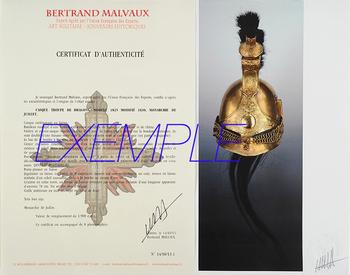
Next update Friday, november 28 at 13:30 PM
FOR ALL PURCHASES, PAYMENT IN MULTIPLE CHECKS POSSIBLE
bertrand.malvaux@wanadoo.fr 06 07 75 74 63
SHIPPING COSTS
Shipping costs are calculated only once per order for one or more items, all shipments are sent via registered mail, as this is the only way to have proof of dispatch and receipt.
For parcels whose value cannot be insured by the Post, shipments are entrusted to DHL or Fedex with real value insured, the service is of high quality but the cost is higher.
RETURN POLICY
Items can be returned within 8 days of receipt. They must be returned by registered mail at the sender's expense, in their original packaging, and in their original condition.
AUTHENTICITY
The selection of items offered on this site allows me to guarantee the authenticity of each piece described here, all items offered are guaranteed to be period and authentic, unless otherwise noted or restricted in the description.
An authenticity certificate of the item including the description published on the site, the period, the sale price, accompanied by one or more color photographs is automatically provided for any item priced over 130 euros. Below this price, each certificate is charged 5 euros.
Only items sold by me are subject to an authenticity certificate, I do not provide any expert reports for items sold by third parties (colleagues or collectors).
FOR ALL PURCHASES, PAYMENT IN MULTIPLE CHECKS POSSIBLE
bertrand.malvaux@wanadoo.fr 06 07 75 74 63
An authenticity certificate of the item including the description published on the site, the period, the sale price, accompanied by one or more color photographs is automatically provided for any item priced over 130 euros. Below this price, each certificate is charged 5 euros.
Only items sold by me are subject to an authenticity certificate, I do not provide any expert reports for items sold by third parties (colleagues or collectors).
